高中英语必修四Unit 4 Body language 说课大赛课件
文档属性
| 名称 | 高中英语必修四Unit 4 Body language 说课大赛课件 |
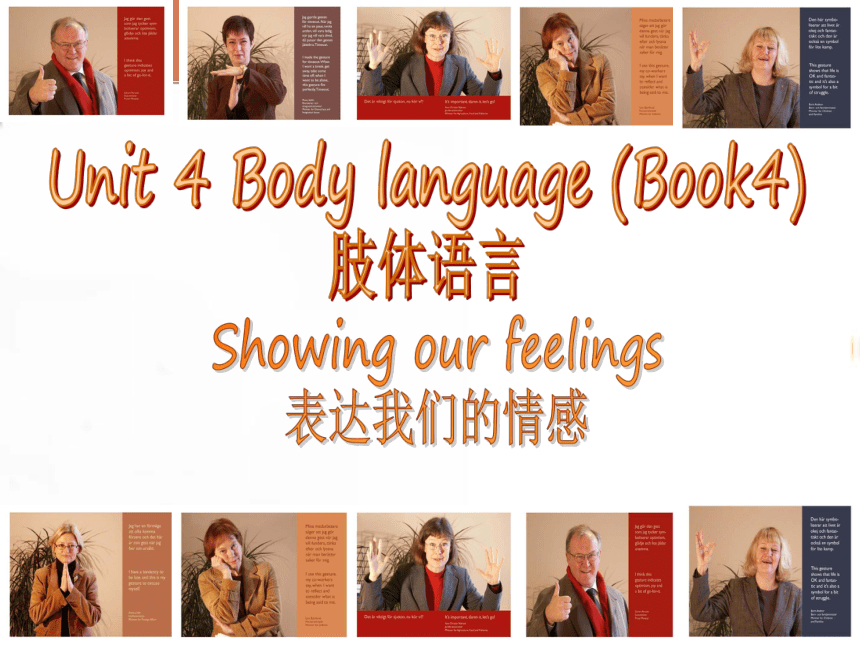
|
|
| 格式 | zip | ||
| 文件大小 | 2.2MB | ||
| 资源类型 | 教案 | ||
| 版本资源 | 人教版(新课程标准) | ||
| 科目 | 英语 | ||
| 更新时间 | 2016-12-25 21:44:43 | ||
图片预览



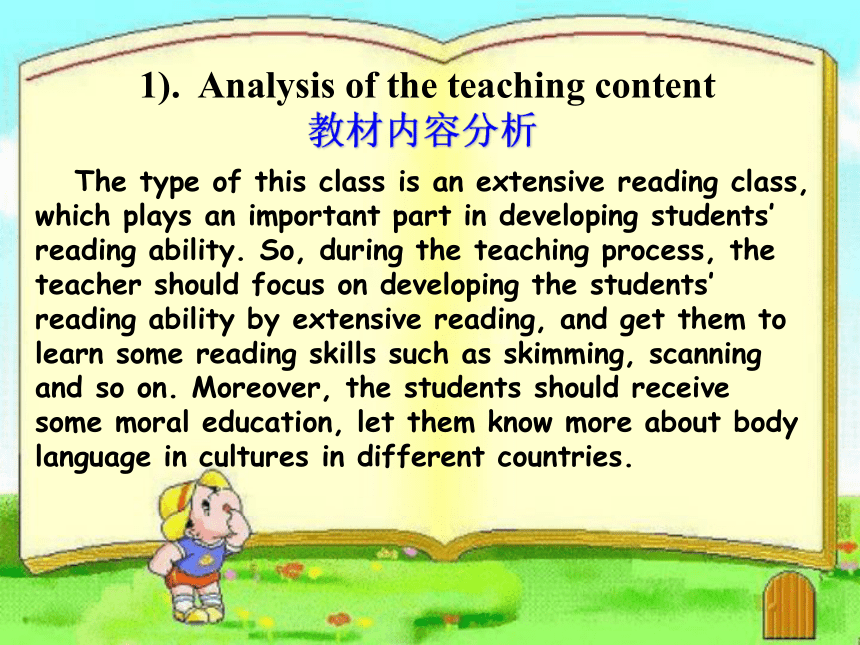

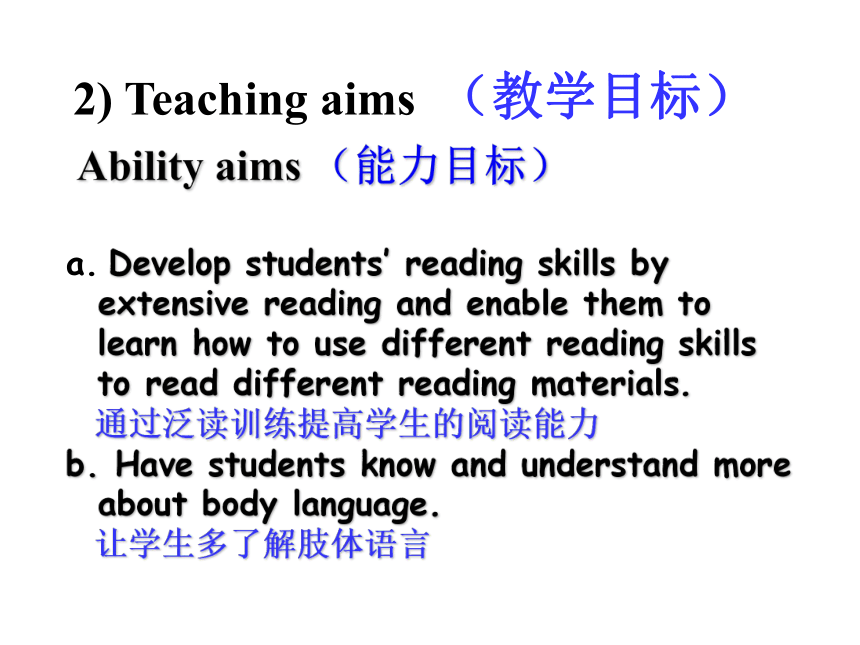

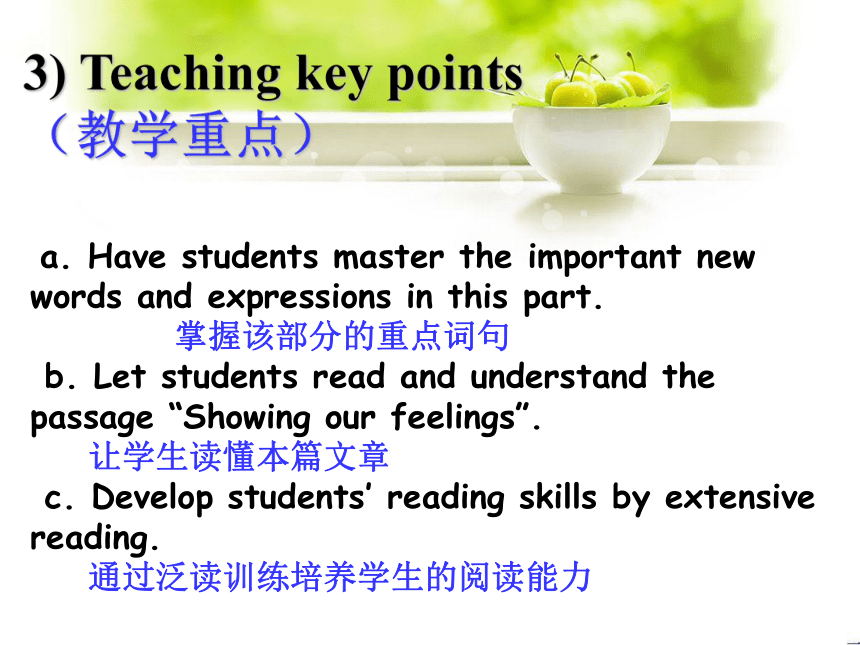


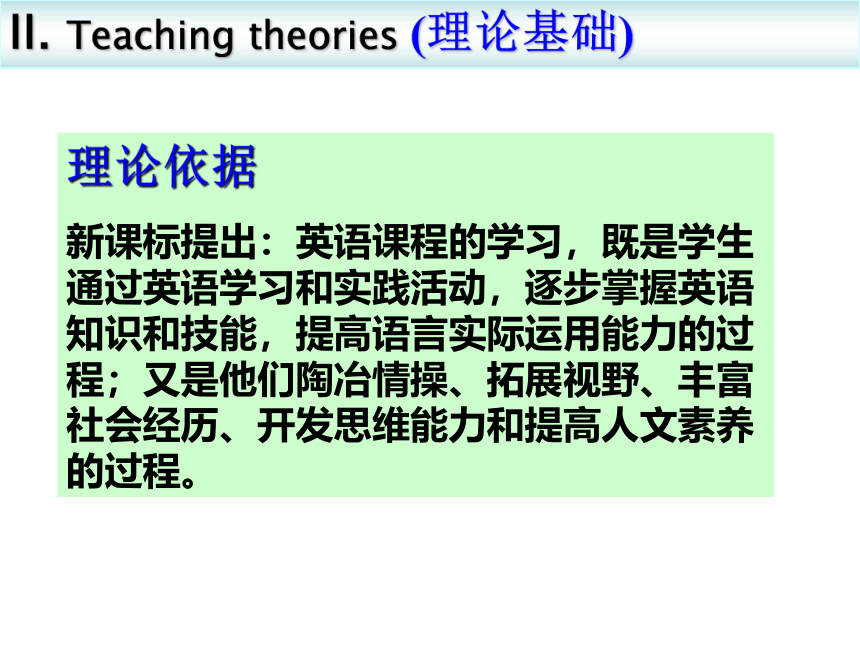
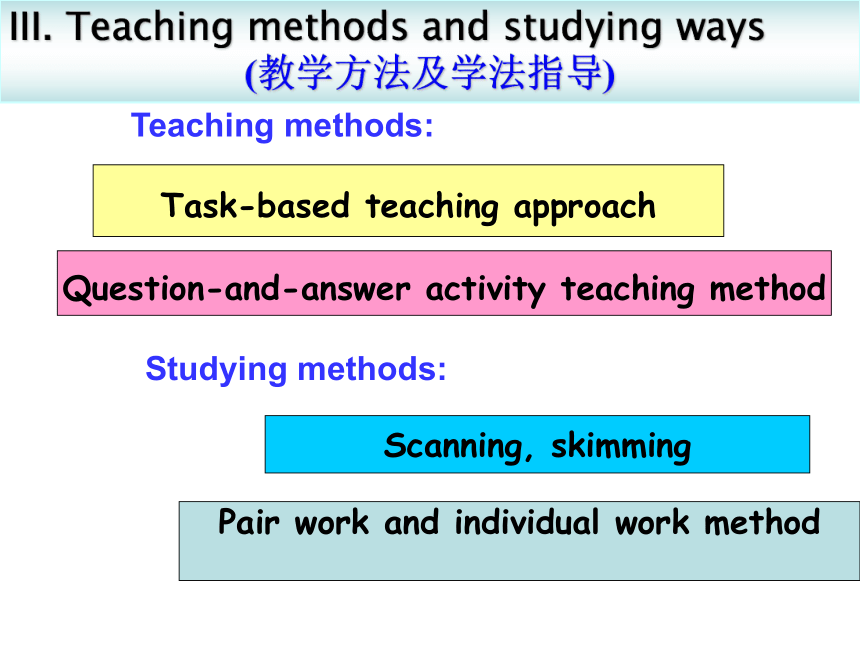
文档简介
课件30张PPT。Unit 4 Body language (Book4)
肢体语言Showing our feelings
表达我们的情感 Main ContentsI. Analysis of teaching materialII. Teaching theoriesIII. Teaching methods and studying waysIV. Teaching proceduresV. Blackboard designVI. Teaching evaluationAnalysis of the teaching material
(教材分析) Knowledge aims 知识目标 Ability aims 能力目标3). Teaching key points 教学重点4). Teaching difficult points 教学难点 1). Analysis of the teaching content 教材内容5). The analysis of the students 学生分析2). Teaching aims
教学目标 Emotional aims 情感目标 1). Analysis of the teaching content
教材内容分析 The type of this class is an extensive reading class, which plays an important part in developing students’ reading ability. So, during the teaching process, the teacher should focus on developing the students’ reading ability by extensive reading, and get them to learn some reading skills such as skimming, scanning and so on. Moreover, the students should receive some moral education, let them know more about body language in cultures in different countries.
Knowledge aims (知识目标)a. Get students to learn the following useful new words and expressions: unspoken, facial, functional, ease, truly, false, anger, fist, yawn, subjective, hug, rank, at ease, face, turn one’s back to…
掌握重点词句
b. Get students to read the passage and let them know more about body language.
阅读文章,更多了解肢体语言
2) Teaching aims (教学目标)Ability aims (能力目标)a. Develop students’ reading skills by extensive reading and enable them to learn how to use different reading skills to read different reading materials.
通过泛读训练提高学生的阅读能力
b. Have students know and understand more about body language.
让学生多了解肢体语言
2) Teaching aims (教学目标)Emotional aims (情感目标)a. Let students have a better understanding of body language in different cultures and try to avoid misunderstanding.
了解中外文化的区别
b. Develop students’ sense of group cooperation and teamwork.
培养学生的合作精神
2) Teaching aims (教学目标)3) Teaching key points
(教学重点) a. Have students master the important new words and expressions in this part.
掌握该部分的重点词句
b. Let students read and understand the passage “Showing our feelings”.
让学生读懂本篇文章
c. Develop students’ reading skills by extensive reading.
通过泛读训练培养学生的阅读能力4) Teaching difficult points
(教学难点)a. How to get the students to grasp the main idea and the key words of each paragraph as quickly as possible
把握文章大意,掌握重点单词
b. How to finish a task: act out different ways of greetings and describe the performance
理解并运用身势语
5). Analysis of the students 学生分析 As to the students of class 5&6, most of them are poor in English, they show little interest in learning English, and they are lack of vocabulary and confidence. So, during the teaching process, the teacher should focus on how to arouse their interest in English. In addition, the teacher should teach them the proper way to learn English and encourage them to learn English well.II. Teaching theories (理论基础)理论依据
新课标提出:英语课程的学习,既是学生通过英语学习和实践活动,逐步掌握英语知识和技能,提高语言实际运用能力的过程;又是他们陶冶情操、拓展视野、丰富社会经历、开发思维能力和提高人文素养的过程。 III. Teaching methods and studying ways
(教学方法及学法指导)Task-based teaching approachQuestion-and-answer activity teaching methodScanning, skimmingPair work and individual work method
Teaching methods:Studying methods:Step 1 Lead-in(导入)Two activities:
a. What’s the meaning of the following gestures?
b. What’s the meaning of the following face expressions? IV. Teaching procedures (教学过程)Gestures 手势Facial expressions (表情) anger
joy
sorrow fear
disgust
surprise
Discussion(讨论)What is the fun_ction of body language?(肢体语言的作用)
b. What do think the role of body language in our daily life? (肢体语言的地位)
c. Are all the body language the same in the world? What do you know about them?(所有的肢体语言都是一样吗?)
Step 2. Pre-reading (读前)Step 3. While-reading
(读中)a. Fast-reading (快速阅读)
b. Detail-reading(细节阅读)Find out the topic
sentences of each paragraph
找出每段的大意Fast-reading
快速阅读Part 1 (Para.1)
Body language shows all kinds of feelings,wishes and attitudes and sometimes more important than spoken language. Part 2 (Para.2-Para.6)
Denotation and examples of some body language.Part 3 (Para.7-Para.8)
There are differences in body language,
it’s important for us to know them.Detail-reading
细节阅读训练阅读
提高语言组织能力Read the passage carefully and finish the following reading tasks.
完成下列阅读任务Task 1Decide whether the
following statements
true or false
判断对错Body language is never as important as spoken language.
2. If you are angry at a person, you might turn your back to him or her.
3. You can threaten a person by refusing to speak.
4. If you stand with your arms across your body, you are always protecting yourself from being physically attacked.FTFFTask 2Answer the following questions according to the text 根据课文回答问题1.How can we know others’ feelings, even if they do not speak to us?2.Why should we be careful with our body language?3.Why is it important to watch as well as listen to others?4.What are some jobs in which using body language is extremely important?Discussion (讨论)a. How can we know other’s feelings, even if they do not speak to us?
b. Why should we be careful of our own body language ?
c. Why is it important to watch others as well as listen to them?培养合作精神Step 4. Post-reading (读后)Step 5 Post-class Extension
(课后拓展 )a. Surf on the Internet, try to know more about body language and tell your classmates.
b. Finish a paper.
Step 6. Homework (作业布置)a. Recite the new words and expressions of this part.
b. Read through the passage after class.
c. Finish off the workbook exercises.
d. Prepare for the next period. V. Blackboard design (板书设计)I. Pre-reading II. While-reading 1.The main idea of each paragraph2.True or false3. Answer questions4.Differences and similarities in body languageIII. Post-reading VI. Teaching evaluation (教学评价)1. Face all students, design different activities, try hard to arouse students’ interest. (开展多种教学活动,激发学生兴趣)2. Regard the students as the nucleus of teaching and respect the individual differences. (坚持学生的主体作用,尊重个体差异性)3. Attach as many opportunities as possible for the students to output after input. (尽量多给学生机会进行知识输出) Thanks for your listening
肢体语言Showing our feelings
表达我们的情感 Main ContentsI. Analysis of teaching materialII. Teaching theoriesIII. Teaching methods and studying waysIV. Teaching proceduresV. Blackboard designVI. Teaching evaluationAnalysis of the teaching material
(教材分析) Knowledge aims 知识目标 Ability aims 能力目标3). Teaching key points 教学重点4). Teaching difficult points 教学难点 1). Analysis of the teaching content 教材内容5). The analysis of the students 学生分析2). Teaching aims
教学目标 Emotional aims 情感目标 1). Analysis of the teaching content
教材内容分析 The type of this class is an extensive reading class, which plays an important part in developing students’ reading ability. So, during the teaching process, the teacher should focus on developing the students’ reading ability by extensive reading, and get them to learn some reading skills such as skimming, scanning and so on. Moreover, the students should receive some moral education, let them know more about body language in cultures in different countries.
Knowledge aims (知识目标)a. Get students to learn the following useful new words and expressions: unspoken, facial, functional, ease, truly, false, anger, fist, yawn, subjective, hug, rank, at ease, face, turn one’s back to…
掌握重点词句
b. Get students to read the passage and let them know more about body language.
阅读文章,更多了解肢体语言
2) Teaching aims (教学目标)Ability aims (能力目标)a. Develop students’ reading skills by extensive reading and enable them to learn how to use different reading skills to read different reading materials.
通过泛读训练提高学生的阅读能力
b. Have students know and understand more about body language.
让学生多了解肢体语言
2) Teaching aims (教学目标)Emotional aims (情感目标)a. Let students have a better understanding of body language in different cultures and try to avoid misunderstanding.
了解中外文化的区别
b. Develop students’ sense of group cooperation and teamwork.
培养学生的合作精神
2) Teaching aims (教学目标)3) Teaching key points
(教学重点) a. Have students master the important new words and expressions in this part.
掌握该部分的重点词句
b. Let students read and understand the passage “Showing our feelings”.
让学生读懂本篇文章
c. Develop students’ reading skills by extensive reading.
通过泛读训练培养学生的阅读能力4) Teaching difficult points
(教学难点)a. How to get the students to grasp the main idea and the key words of each paragraph as quickly as possible
把握文章大意,掌握重点单词
b. How to finish a task: act out different ways of greetings and describe the performance
理解并运用身势语
5). Analysis of the students 学生分析 As to the students of class 5&6, most of them are poor in English, they show little interest in learning English, and they are lack of vocabulary and confidence. So, during the teaching process, the teacher should focus on how to arouse their interest in English. In addition, the teacher should teach them the proper way to learn English and encourage them to learn English well.II. Teaching theories (理论基础)理论依据
新课标提出:英语课程的学习,既是学生通过英语学习和实践活动,逐步掌握英语知识和技能,提高语言实际运用能力的过程;又是他们陶冶情操、拓展视野、丰富社会经历、开发思维能力和提高人文素养的过程。 III. Teaching methods and studying ways
(教学方法及学法指导)Task-based teaching approachQuestion-and-answer activity teaching methodScanning, skimmingPair work and individual work method
Teaching methods:Studying methods:Step 1 Lead-in(导入)Two activities:
a. What’s the meaning of the following gestures?
b. What’s the meaning of the following face expressions? IV. Teaching procedures (教学过程)Gestures 手势Facial expressions (表情) anger
joy
sorrow fear
disgust
surprise
Discussion(讨论)What is the fun_ction of body language?(肢体语言的作用)
b. What do think the role of body language in our daily life? (肢体语言的地位)
c. Are all the body language the same in the world? What do you know about them?(所有的肢体语言都是一样吗?)
Step 2. Pre-reading (读前)Step 3. While-reading
(读中)a. Fast-reading (快速阅读)
b. Detail-reading(细节阅读)Find out the topic
sentences of each paragraph
找出每段的大意Fast-reading
快速阅读Part 1 (Para.1)
Body language shows all kinds of feelings,wishes and attitudes and sometimes more important than spoken language. Part 2 (Para.2-Para.6)
Denotation and examples of some body language.Part 3 (Para.7-Para.8)
There are differences in body language,
it’s important for us to know them.Detail-reading
细节阅读训练阅读
提高语言组织能力Read the passage carefully and finish the following reading tasks.
完成下列阅读任务Task 1Decide whether the
following statements
true or false
判断对错Body language is never as important as spoken language.
2. If you are angry at a person, you might turn your back to him or her.
3. You can threaten a person by refusing to speak.
4. If you stand with your arms across your body, you are always protecting yourself from being physically attacked.FTFFTask 2Answer the following questions according to the text 根据课文回答问题1.How can we know others’ feelings, even if they do not speak to us?2.Why should we be careful with our body language?3.Why is it important to watch as well as listen to others?4.What are some jobs in which using body language is extremely important?Discussion (讨论)a. How can we know other’s feelings, even if they do not speak to us?
b. Why should we be careful of our own body language ?
c. Why is it important to watch others as well as listen to them?培养合作精神Step 4. Post-reading (读后)Step 5 Post-class Extension
(课后拓展 )a. Surf on the Internet, try to know more about body language and tell your classmates.
b. Finish a paper.
Step 6. Homework (作业布置)a. Recite the new words and expressions of this part.
b. Read through the passage after class.
c. Finish off the workbook exercises.
d. Prepare for the next period. V. Blackboard design (板书设计)I. Pre-reading II. While-reading 1.The main idea of each paragraph2.True or false3. Answer questions4.Differences and similarities in body languageIII. Post-reading VI. Teaching evaluation (教学评价)1. Face all students, design different activities, try hard to arouse students’ interest. (开展多种教学活动,激发学生兴趣)2. Regard the students as the nucleus of teaching and respect the individual differences. (坚持学生的主体作用,尊重个体差异性)3. Attach as many opportunities as possible for the students to output after input. (尽量多给学生机会进行知识输出) Thanks for your listening
同课章节目录
